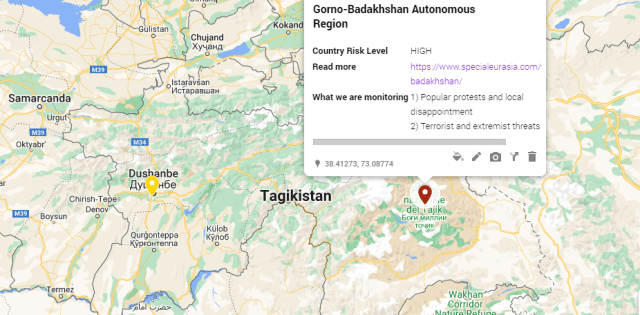
Author: Giuliano Bifolchi
In Tajikistan, local security forces and authorities emphasised the rising threat of terrorism and extremism in the country in the last six months, confirming that terrorist organisations such as the Islamic State have been able to exploit local disappointment and the unresolved issues that in Gorno-Badakhshan.
The Prosecutor General of the Republic of Tajikistan stated that the number of terrorists and extremists has increased over the past six months. Tajik security forces registered in the first half of the year 720 crimes related to extremism and terrorism. According to Rahmon, this is 106 illegal acts more than in the first six months of 2021.
Earlier, the country’s Prosecutor General’s Office reported on activities over the past six months. The department said that law enforcement officers opened 2,487 criminal cases from January to June. In addition, more than 20 thousand Tajikistan citizens committed administrative offences during the specified period.
Geopolitical scenario
Terrorism and extremism are among the main threats to Tajik security and stability. Since the U.S. troops’ withdrawal from Afghanistan and the Taliban’s rise to power, Dushanbe has considered fundamental contrast any terrorist threat from Afghanistan and stabilise the Tajik-Afghan borders.
The Russian Federation needs a stable and safe Tajikistan because the country might be considered the Kremlin’s outpost in Central Asia. In this regard, since Washington announced their complete withdrawal from Afghanistan and after the Taliban took power in Kabul, Moscow has strictly cooperated with Dushanbe to guarantee local security and avoid the spread of terrorism and extremism (Tajikistan: the Kremlin’s frontier against the Taliban).
In May 2022, the Gorno-Badakhshan Autonomous Region (GBAO) registered local protests against the central government, which erupted in clashes between the demonstrators and security forces. Therefore, the Tajik government started an anti-terrorism operation in the region, alleging that external forces and extremist groups tried to exploit the situation with the final goal to destabilise the regional socio-political situation (Political tensions and security threats in Tajikistan).
Due to its geographical position, China has shown its interest in stabilising the GBAO, which shares borders with Afghanistan and the Xinjiang Uygur Autonomous Region (XUAR), supporting the construction of a military base in the region to control the area and reduce the possibility that Uygur foreign fighters might use the GBAO has a ‘bridge’ between the Chinese and the Afghan territory (Chinese military base in Tajikistan: regional implications).
Risk assessment
Since 2022, Central Asia has registered widespread disappointment and local demonstrations due to socio-economic problems, domestic political issues, and the challenging relations between central authorities and ethnic minorities.
The protests in Kazakhstan, Tajikistan, and Uzbekistan (Geopolitical consequences of the political crisis in Kazakhstan; Mass riots and protests in the Uzbek autonomous Republic of Karakalpakstan), which local governments reprimed by using the strategy of conducting ‘anti-terrorist operation against external agents and extremist groups’ have underlined how popular resentment, authoritarianism, and corruption might exacerbate the security situation and create the fertile ground for jihadist propaganda, especially after the Islamic State Khurasan Province (ISKP) started a campaign in Tajik, Uzbek, and Kyrgyz languages to recruit foreign fighters in Central Asia (Islamic State Khurasan Province threatens Uzbekistan, Central Asia, and neighbouring countries).



